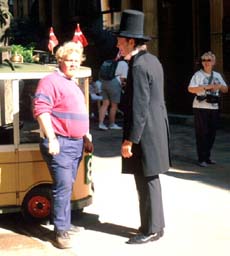index
Themed places show themselves as other
click on images for full-size:



Ironic sign at Disney's Animal Kingdom park

Themed character conversing with a patron at Tivoli park in Copenhagen
We need to be able to distinguish between a themed place and other kinds of self-conscious places. Rome is flamboyantly Italian; is it then a themed place? In a themed place the normative grammar is self-consciously presented as other and as different from the local everyday expectations. If a place does not put itself forward as representing something other, but is just a place where people live in a different manner, even quite self-consciously so, it may still be a tourist destination, but it is not a themed place. Having a different mode of life is not the same as self-consciously representing a different mode of life. Being a piece of another culture is not the same as being a self-consciously presented representation of that culture. Boston's North End, or the ethnic neighborhoods in Chicago, once offered visitors a chance to encounter a different way of life going on -- in the behavior and body language of the inhabitants, in their use of public areas, in food, and so on. This was more like visiting another country than visiting a themed replica.
- [Return to "what is a theme?"]
- [Nearby: Themed places outline -- What a theme is not -- Better ways of discussing themed places ]